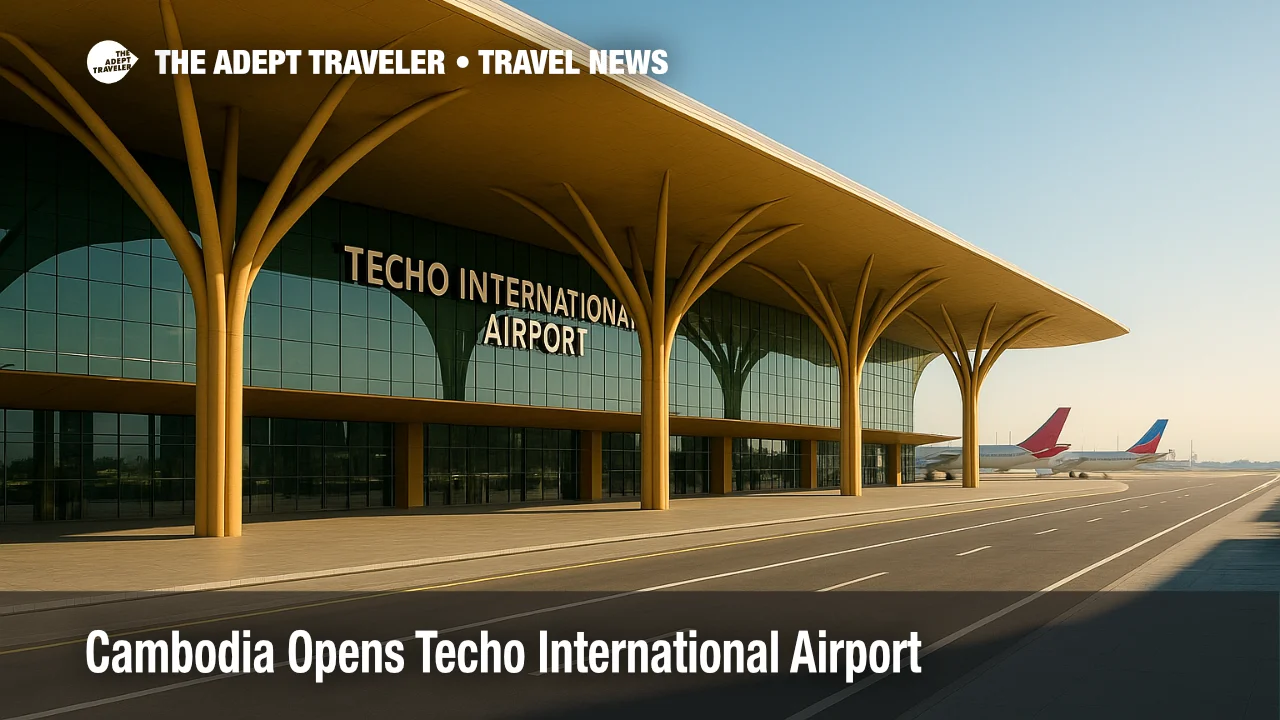Techo International Airport opens, reshaping Phnom Penh's air gateway

Cambodia has opened Techo International Airport (KTI), a new greenfield hub south of Phnom Penh that launched commercial operations on September 9, 2025. Designed by Foster + Partners and owned by Cambodia Airport Investment Co. (CAIC), the first phase can handle 15 million passengers a year and consolidates the capital's international traffic under one roof. The debut included a water-salute arrival by Air Cambodia and, within weeks, the airport temporarily hosted Cathay Pacific aircraft displaced by Super Typhoon Ragasa, underscoring its operational scale and regional relevance. Vinci Airports now operates the facility alongside global retail, catering, and MRO partners.
Key points
- Why it matters: Cambodia adds a modern 4F-class hub with 15 million annual capacity in phase one.
- Travel impact: International flights for Phnom Penh now use KTI; check itineraries and ground access.
- What's next: Further build-out targets 30 million by 2030 and 50 million at full completion.
- Foster + Partners terminal uses "structural trees," tropical landscaping, and a nine-meter Buddha.
- Global partners include Vinci Airports, Lagardère Travel Retail, Newrest, and SIA Engineering Company.
Snapshot
Techo International Airport sits about 20 kilometers south of the capital and replaces the city's former international gateway for commercial operations. The CAIC joint venture between the State Secretariat of Civil Aviation and OCIC led development across a 2,600-hectare site, mobilizing more than 200 Cambodian engineers and 17,000 workers. The terminal's Angkor-inspired form uses sweeping roof canopies supported by "structural trees," with natural light and tropical plantings shaping the interior. Early operations featured an inaugural Air Cambodia arrival with a traditional water salute. During Super Typhoon Ragasa, Cathay Pacific repositioned multiple aircraft to Phnom Penh, with KTI accommodating the jets while maintaining scheduled movements.
Background
Phnom Penh's aviation upgrade aligns with Cambodia's broader tourism and trade strategy. The first-phase throughput is 13 to 15 million passengers annually, with staged expansion to 30 million by 2030 and up to 50 million at full build-out. Vinci Airports was appointed to operate KTI, extending three decades of airport experience in Cambodia. Foster + Partners' masterplan anticipates an "airport city" with sustainable features and short walking distances, while on-site partners cover retail, food service, and maintenance. The facility opened after extensive trials, and airlines have begun migrating timetables and customer information to the KTI code. Travelers should verify airport transfers and arrival procedures during the transition period.
Latest developments
Phnom Penh's new hub adds routes and proves storm-ready
Within its first month, KTI saw two route additions while also serving as a weather haven for Cathay Pacific aircraft as Ragasa disrupted Hong Kong operations. The airport reported 13 Cathay wide- and narrow-body aircraft parked safely on stand over several days, illustrating apron capacity and coordination while commercial flights continued. Retail and dining have ramped up, blending Cambodian brands such as Malis, Brown Coffee, Bodia, and Artisans d'Angkor with international names like Paul and Starbucks. With Vinci Airports overseeing operations, Lagardère Travel Retail curating shops, Newrest handling catering, and SIA Engineering Company supporting MRO, opening-month performance points to a stable ramp-up toward peak season. For day-to-day disruption context, see our running coverage in Flight Delays and Airport Impacts: October 3, 2025.
Analysis
Techo International Airport immediately shifts Cambodia's aviation center of gravity. The greenfield site enables longer runway length, greater gate and remote stand capacity, and modern ground systems that the former field could not accommodate at scale. Inaugural operations showcased a coordinated airline migration, and the Ragasa episode offered an early real-world resilience test that KTI passed by receiving and parking a double-digit number of Cathay aircraft without pausing scheduled movements. The operator mix is notable: Vinci Airports brings a standardized safety and service playbook, while Lagardère and Newrest are experienced in first-month retail and catering stabilization. Architecturally, the Foster + Partners terminal taps recognizable Angkorian motifs while maximizing daylighting; this provides a distinct identity that should play well with leisure travelers. If subsequent phases pace with demand, KTI positions Phnom Penh for more long-haul and regional connectivity, with carrier announcements likely to cluster around seasonal schedule changes. Watch for incremental route wins as airlines validate turnaround performance, load factors, and yields.
Final thoughts
Techo International Airport is a statement project for Cambodia, combining cultural design language with modern operating muscle. With first-phase capacity at 15 million passengers and expansion on deck, the new hub should reduce pinch points, support route development, and strengthen Cambodia's appeal to visitors and investors. Early storm-response performance, plus the global operator-partner roster, suggests a solid foundation for reliability as traffic scales. As airlines finalize winter schedules and beyond, passengers should confirm the KTI code on tickets and transfer plans. The opening marks a new chapter for Phnom Penh and for travelers transiting the region through Techo International Airport.
Sources
- Techo International Airport official site, news items and KTI operations
- AP: Cambodia opens new airport in Phnom Penh on September 9, 2025
- Vinci Airports: Cambodia Airports to operate Techo International Airport
- Foster + Partners: Techo International Airport project overview
- Reuters: Hong Kong's airlines relocate fleets during Typhoon Ragasa; Cathay jets repositioned to Phnom Penh
- Techo International Airport Instagram: 13 Cathay Pacific aircraft welcomed
- PR Newswire: Phnom Penh's Techo International Airport opens; partners and retail mix
- EVA Air travel news: flights move to KTI from September 9, 2025
- Airport-Technology: capacity and development details
